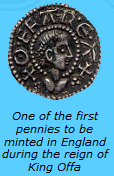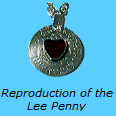
For Coin, Token, Banknote and Medal collectors in the Hornchurch, Romford and Upminster area
The Penny, Some Random Thoughts, By W.E. Mills
The bronze and copper penny is perhaps the most collected coin of the British milled series, and no doubt on account of it's convenient size, availability and comparative cheapness, the one most favoured as a starter by newcomers to numismatics.
Although it was (and is) such a humble coin, it has always been a popular and important unit of our coinage: perhaps rather more important since the introduction of the decimal system, as it is now valued at 100 to the pound sterling instead of 240 as the ''old'' penny was. To me, however its greatest interest lies in the great amount of historical information which can be learned from studying this coin.
The once popular penny was put to many uses. For instance, in Victorian and Edwardian times, and probably much earlier, the old penny was - among the poorer folk - the appropriate coin to place in the church or chapel collecting plate; for a donation to charity or a beggar, or to obtain an extra tune from a street organ grinder. It was also the bright new coin that went into the Christmas stocking. In those days too, it was the custom to place pennies on the eyelids of a person newly dead until rigor mortis set in, to keep them closed.
The 1797 ''Cartwheel'' penny finds a place in most penny collections, and in many the twopenny piece of the same year also. Both these coins have for the past 135 years or so, been used as counterweights for adjustment of the movement of the world's best known clock - Big Ben. This is because the weight of these coins, one and two ounces respectively are so accurate and convenient. For the same reason, both these coins were in common use in Victorian and Edwardian times as weights for shop scales and balances - and their use for this purpose was never questioned.
Even more strangely, the penny was used as a cure. Time was when a cold penny on a string was placed down the backs of people to revive them from faintness. A penny bandaged to the affected part whilst sleeping was said to cure warts. The penny was also used and highly regarded to cure maladies in cattle.
 The
penny has been a unit of English coinage for more than 1,200 years, and
in the following accounts, all substantiated, the pennies used were sometimes
silver and of great antiquity. It is interesting to note that these so-called
''curing'' coins emanated from the north.
The
penny has been a unit of English coinage for more than 1,200 years, and
in the following accounts, all substantiated, the pennies used were sometimes
silver and of great antiquity. It is interesting to note that these so-called
''curing'' coins emanated from the north.
The Lockhart family of Lee in Scotland owned what was known as the ''Lee penny's, which was in great demand in those parts and was often loaned to owners of cattle in the northern counties also. Though this was not really a penny, but a groat of Edward I (new coinage 1279 – 1307) in which on the reverse side, a small dark red triangular stone was set (a bloodstone).
 The
coin had to be dipped in water and the water was then used to cure various
maladies including rabies, haemorrhages and the like. This coin was known
to be used for these purposes during the last century and was held in high
regard. The Lee penny in 1645 was loaned to the town of Newcastle upon Tyne
against a security of £6,000. Apparently it did cure some diseases, because
the town authorities offered to buy the coin, but the Lockharts refused
to sell.
The
coin had to be dipped in water and the water was then used to cure various
maladies including rabies, haemorrhages and the like. This coin was known
to be used for these purposes during the last century and was held in high
regard. The Lee penny in 1645 was loaned to the town of Newcastle upon Tyne
against a security of £6,000. Apparently it did cure some diseases, because
the town authorities offered to buy the coin, but the Lockharts refused
to sell.
The so-called Lockerbie penny's was also of silver, probably another groat, which belonged to the Lockerbie family of Dumfriesshire. This too was loaned to farmers for the cure of cattle diseases. The coin had to be wedged into a forked stick, dipped in water (most probably well water) then turned in the water. This water was then given to the sick beast to drink.
The black penny owned by the Turnbull family of Northumberland was used to cure madness in cattle. The Black penny was borrowed from the Turnbull family for this purpose by Northumberland farmers and also by those in Durham and North Yorkshire. The method advised was to dip the coin in south running water, which when drawn off should be given to the afflicted beast to drink. In 1827 this famous coin was lost; a Morpeth man who borrowed it claimed to have returned it in the post, but it never arrived. One might well reflect on the present whereabouts of this particular curing coin. What lucky collector might have this treasure; it's real worth and quaint history unbeknown to him.
Ah, the humble penny! It has been with us since the eighth century, when it was first minted for the Kings of Kent. A treasure indeed.
